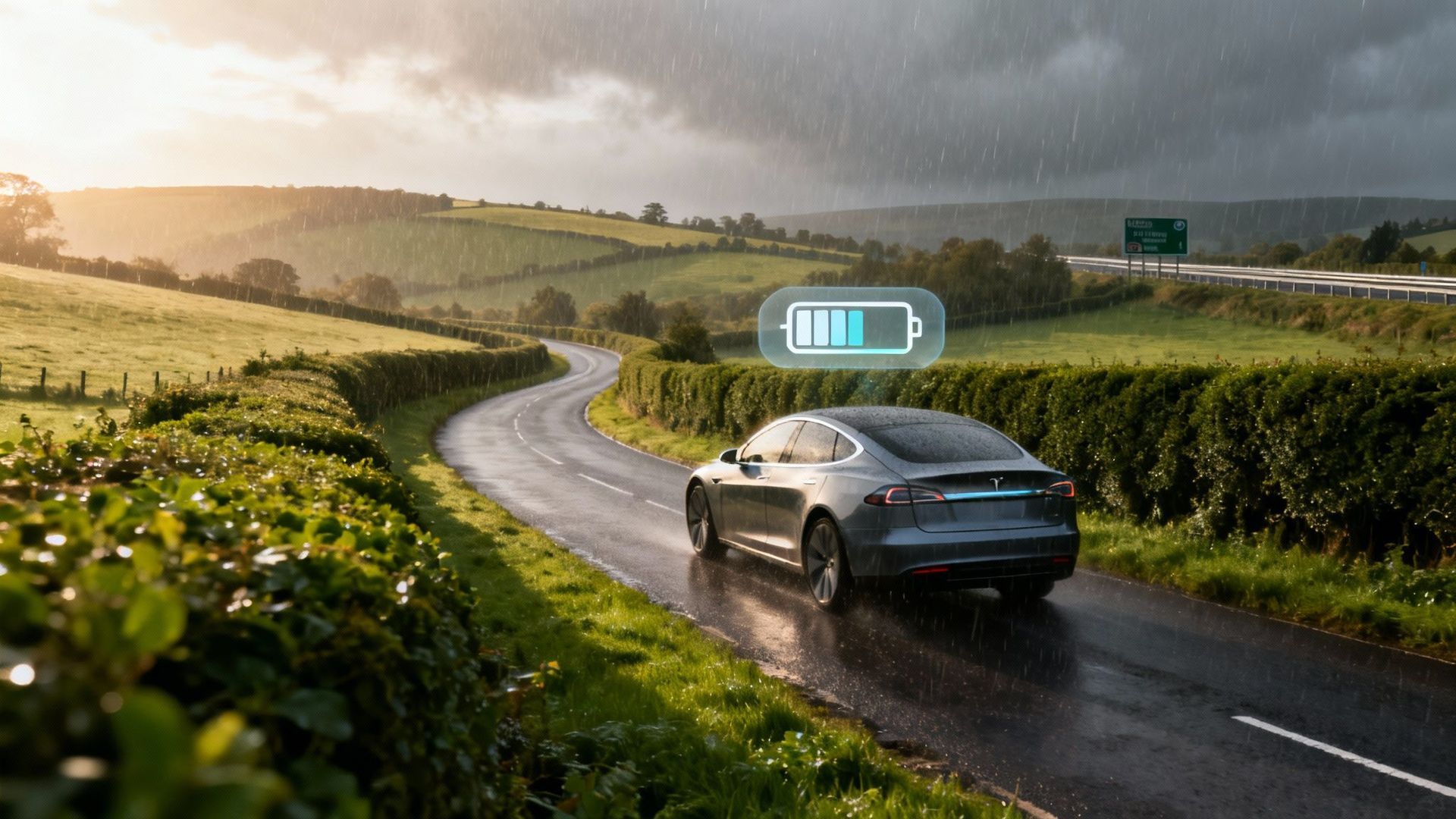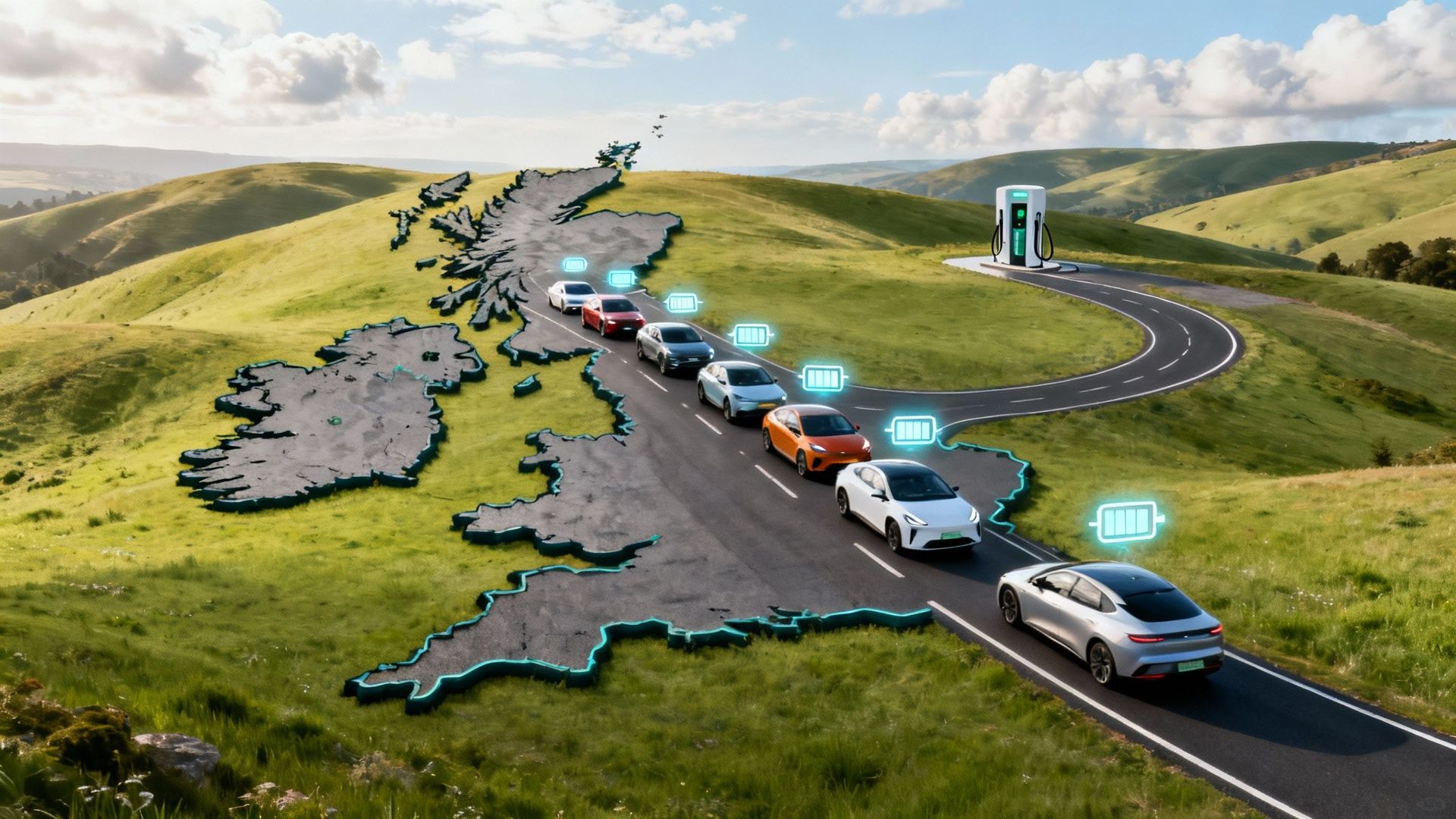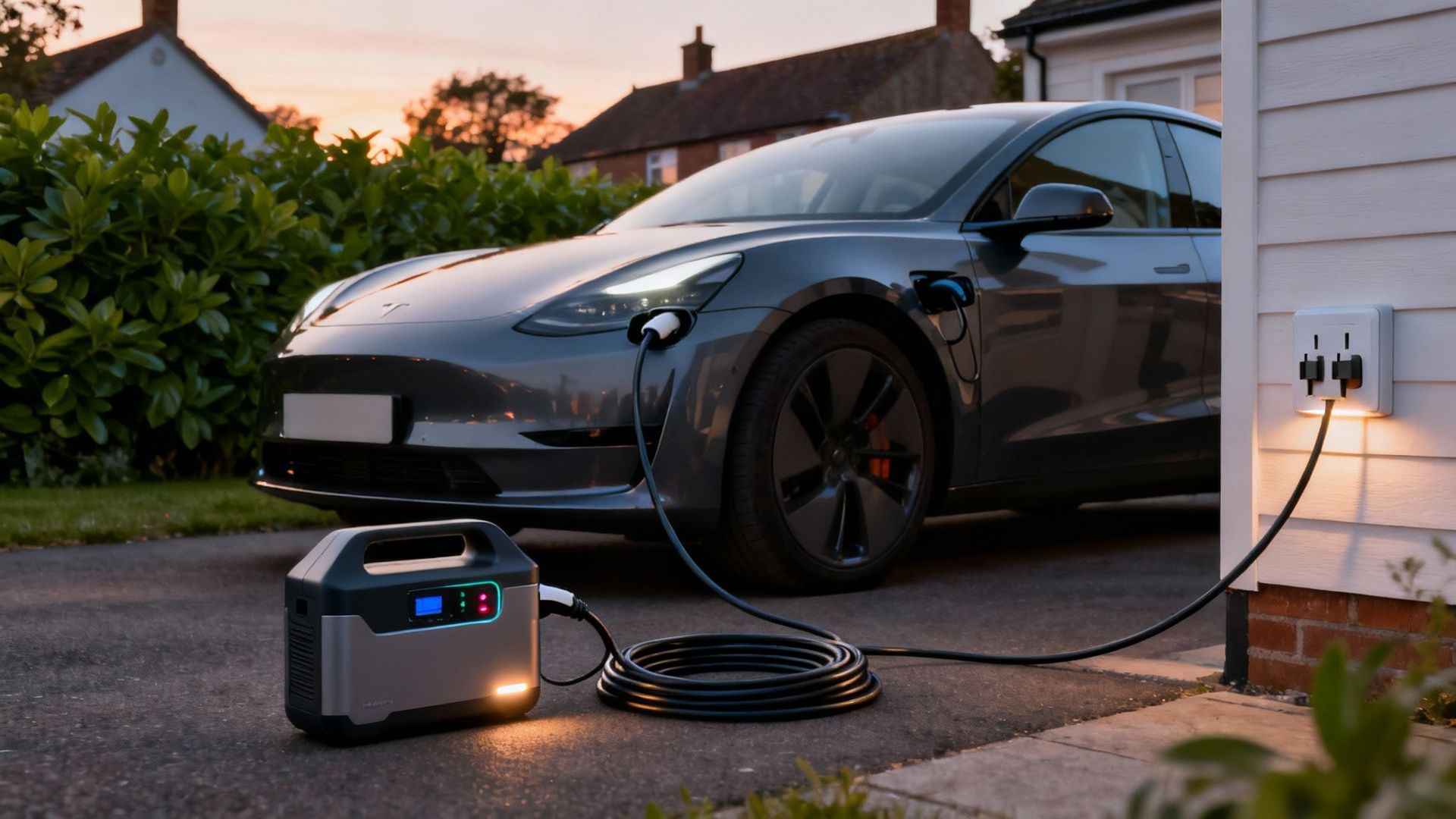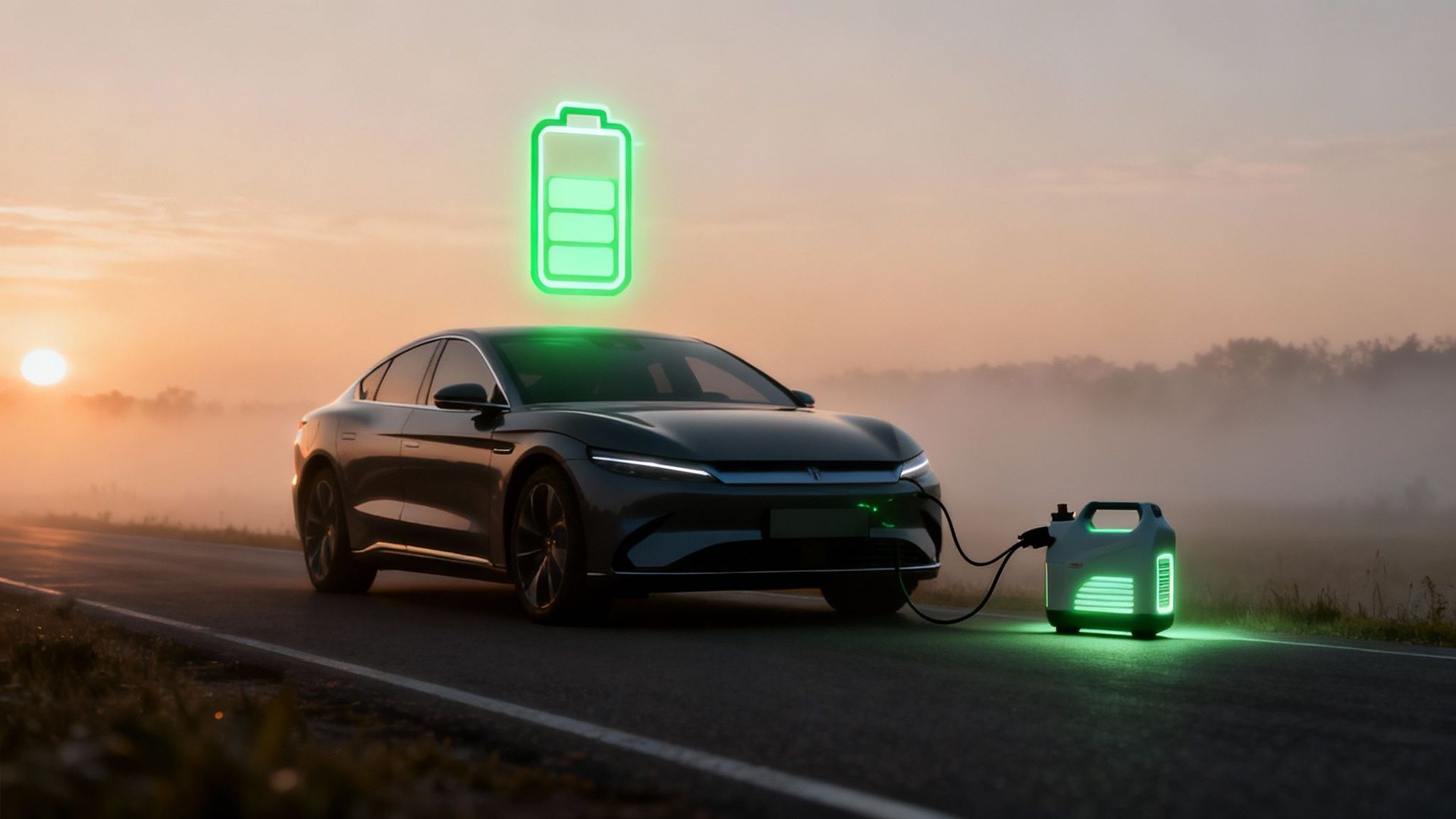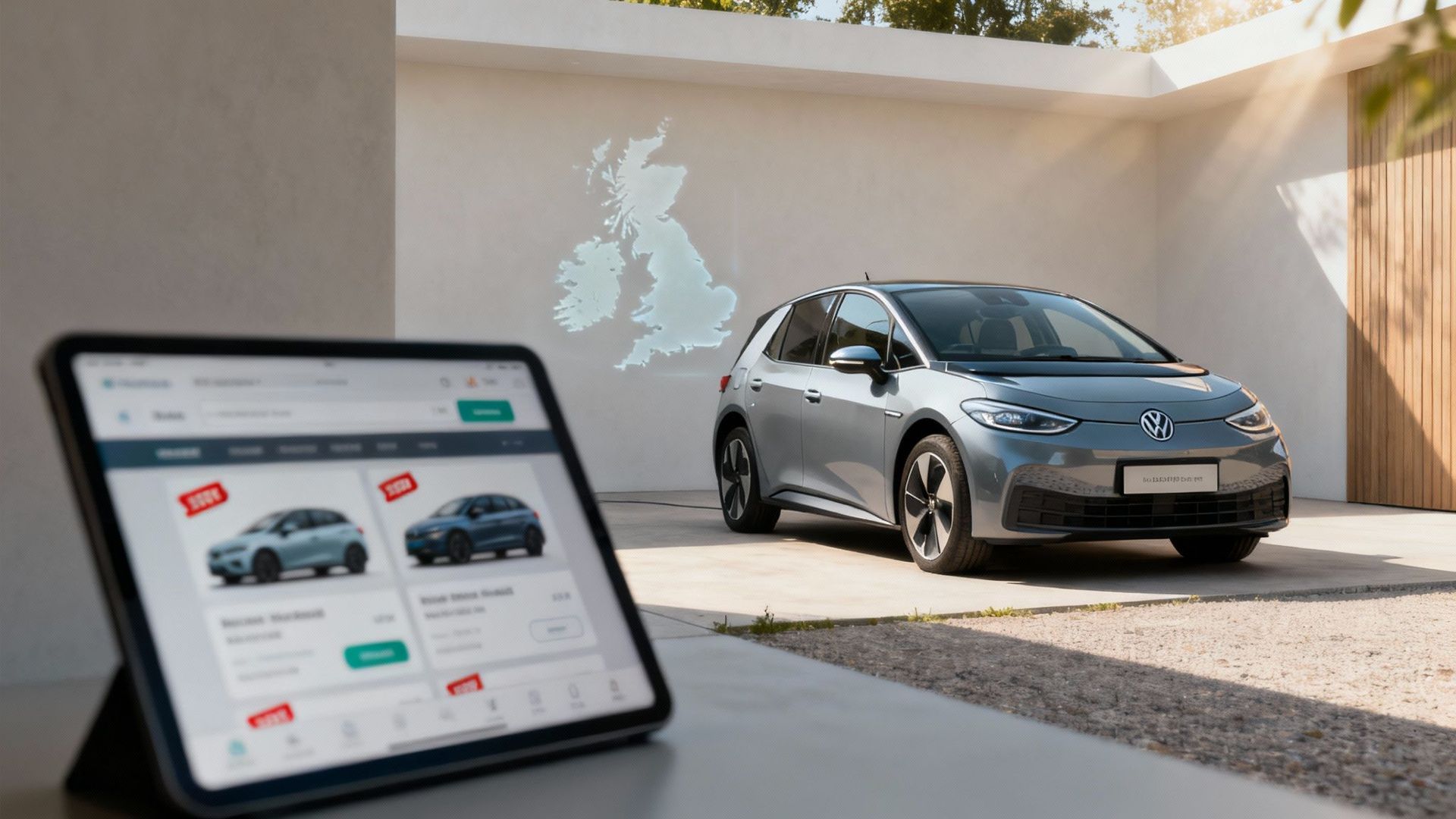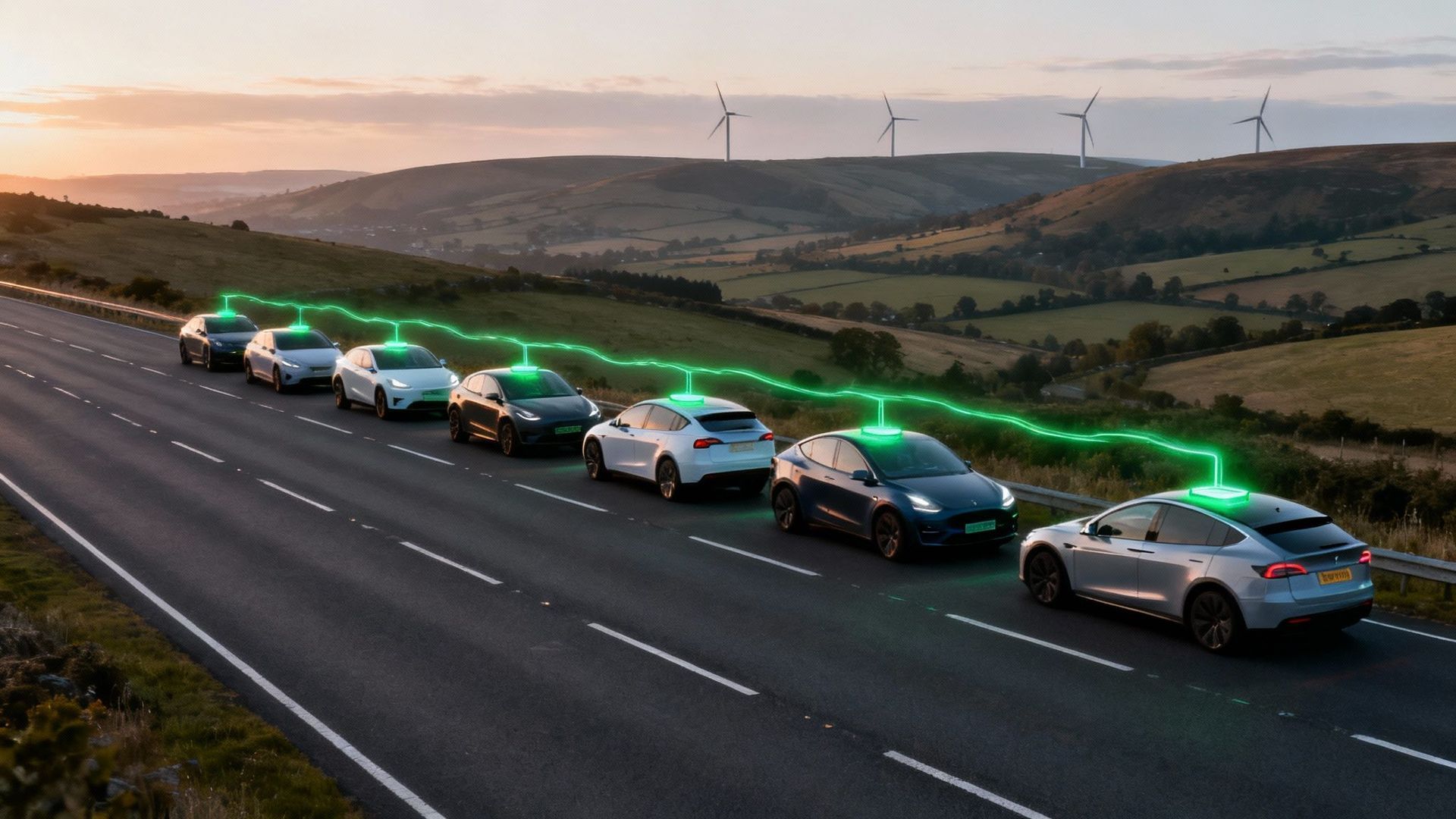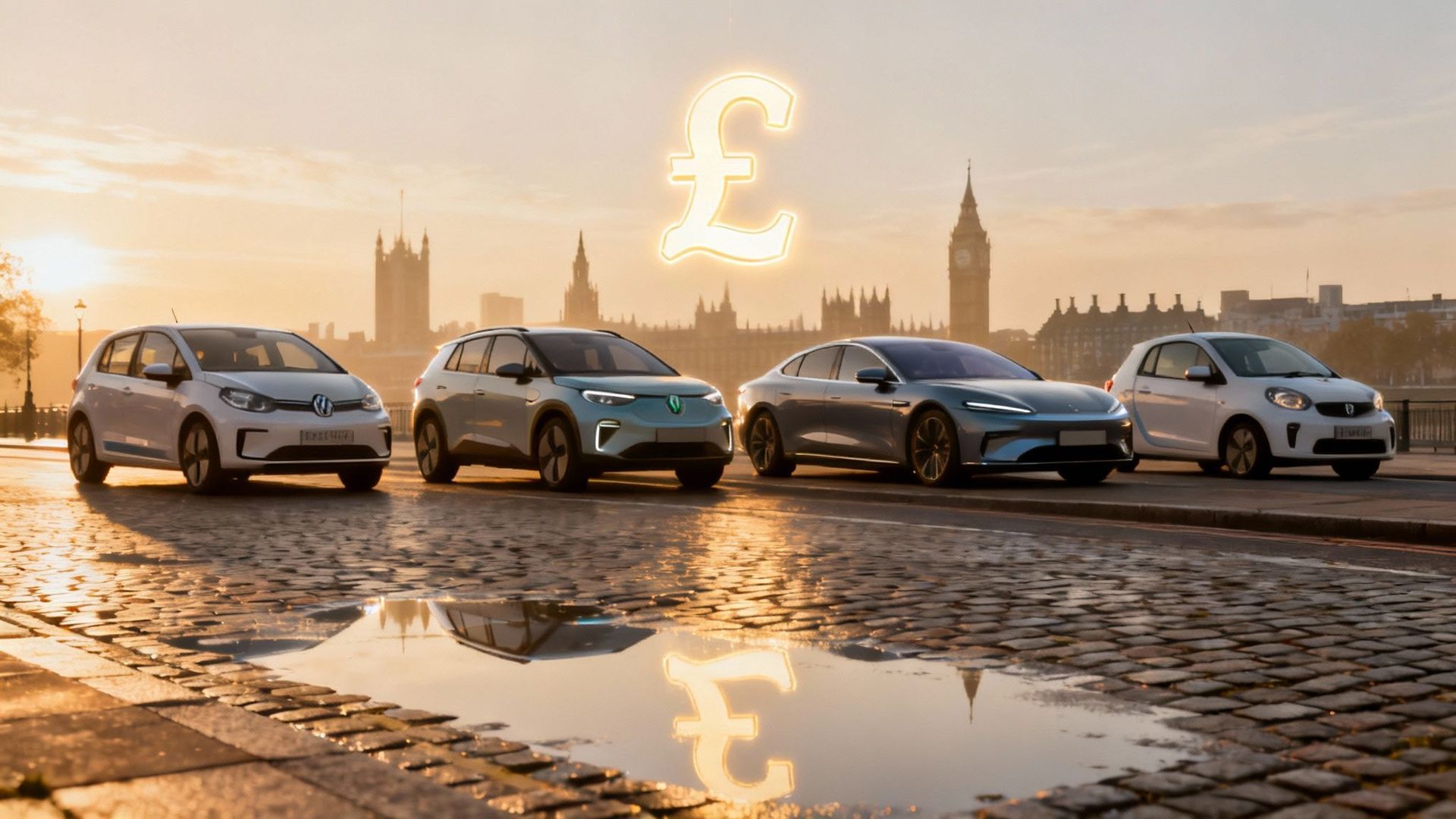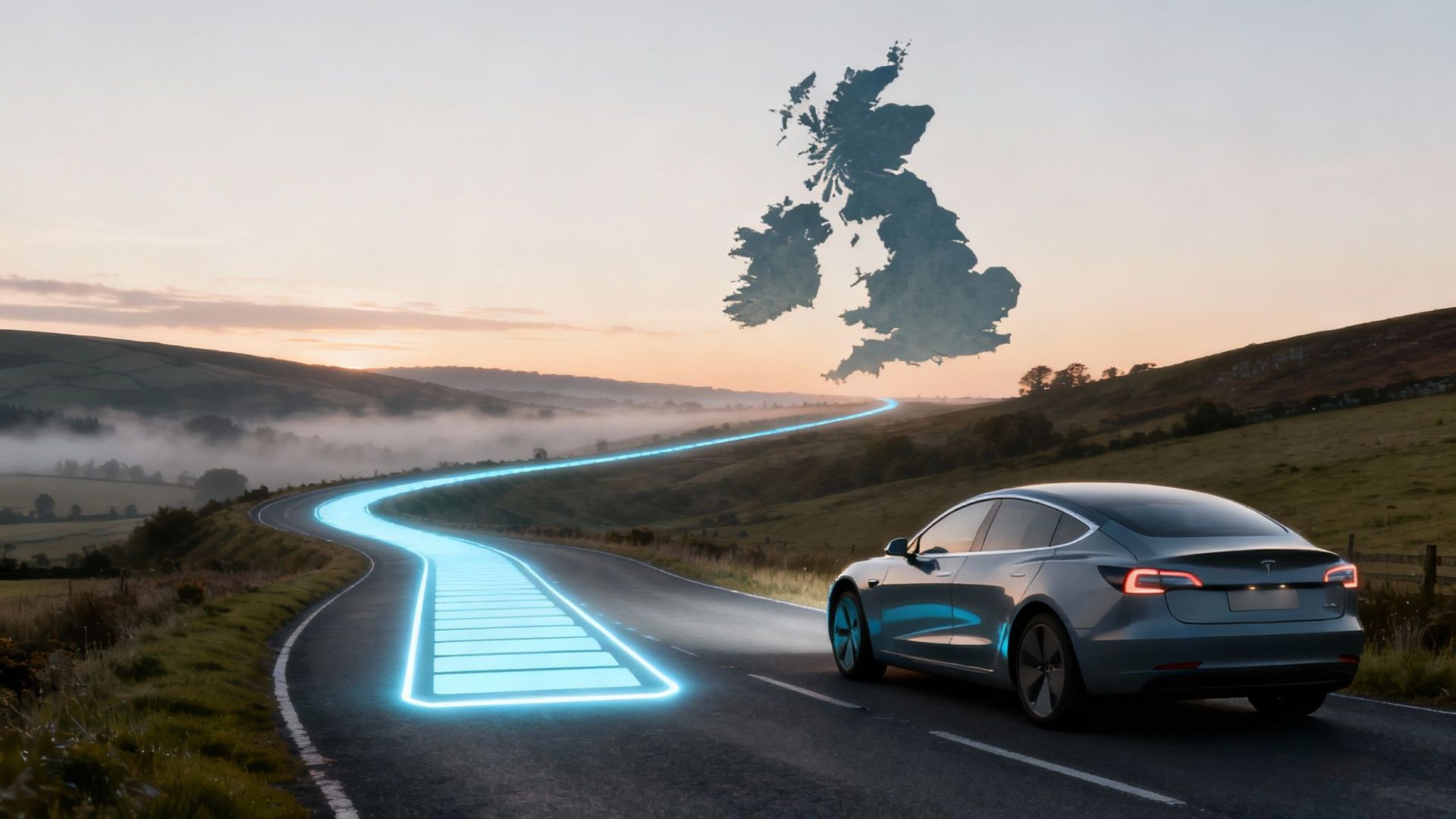So, How Long Do EV Batteries Last? Like, Really?
Let's cut through the noise and get straight to the facts. Forget the scare stories you've heard from Dave down the pub; most electric vehicle batteries are built to outlast the car's questionable upholstery, and then some. We're talking easily cruising past the 10-year, 100,000-mile mark while still clinging on to the vast majority of their original range. They're a world away from the battery in your phone that throws a tantrum if you look at it wrong.
How Long Do EV Batteries Actually Last?

The idea of an EV battery suddenly dying after a few years and leaving you with a bill the size of a small country's GDP is one of the biggest myths out there. The reality is far less dramatic and, frankly, much more reassuring.
An EV battery isn't like the one in your mobile that gives up the ghost after two years of doom-scrolling. Comparing them is like putting a modern jet engine next to a carrier pigeon. Yes, they both serve a purpose, but one is an incredibly sophisticated piece of engineering with complex cooling systems and management software designed purely for longevity and performance.
Putting Numbers to the Nonsense
So, what does the data actually say? It turns out that EV batteries aren't just durable; they are on track to match, and in some cases even surpass, the lifespan of traditional cars with their oily, explody bits.
A recent UK study effectively torpedoed the myth that EVs don't last. It found that the average battery electric vehicle (BEV) has a lifespan of around 18.4 years . That's right on par with petrol vehicles ( 18.7 years ) and actually longer than diesel cars ( 16.8 years ).
The main takeaway is simple: your EV battery is engineered to last the lifetime of the vehicle. The fear of a sudden, catastrophic failure is largely unfounded for the average driver.
To give you a snapshot of how EV battery lifespans stack up against traditional internal combustion engine (ICE) vehicles, here’s a quick comparison.
EV Battery Lifespan At a Glance
| Vehicle Type | Average Lifespan (Years) | Typical Mileage (Miles) | Warranty Period (Years) |
|---|---|---|---|
| Electric Vehicle (EV) | 15 - 20 | 150,000 - 200,000+ | 8 - 10 |
| Petrol/Diesel (ICE) | 12 - 15 | 150,000 - 200,000 | 3 - 5 |
As you can see, the expected lifespan and mileage are very competitive, but the warranty period for the most critical component—the battery—is significantly longer in an EV.
Car manufacturers are so confident in their battery technology that they back it up with substantial warranties. The industry standard is typically 8 years or 100,000 miles , whichever comes first. This isn't just a promise that the battery will function; it's a guarantee that it will retain a specific level of performance, usually around 70% of its original capacity.
For a deeper look into how these power packs work, you can explore our comprehensive guide on EV batteries, the lifeblood of electric vehicles.
What Actually Wears Out an EV Battery?
Think of your EV's battery less like a rugged engine block and more like a sensitive organism. It's built to last, of course, but certain conditions will absolutely cause it to age faster than a pint of milk in the sun. Ignoring its basic needs is the quickest way to see your range start to dwindle.
It's not usually one catastrophic event that does the damage. Instead, it’s a slow and steady process of chemical grumbling, driven by a few specific culprits. These factors gradually chip away at your battery's State of Health (SOH) – that’s the technical term for how much energy it can store compared to when it was shiny and new. For example, a 60 kWh battery with 90% SOH will only hold about 54 kWh of charge.
The Three Horsemen of the Battery Apocalypse
So, what are these bad habits? It really boils down to three things that put stress on the battery's delicate internal chemistry, causing it to lose its ability to hold a full charge over time.
- Extreme Temperatures: Batteries are a bit like Goldilocks – they don't like things too hot or too cold. Relentless summer heat is a well-known enemy, as it speeds up the chemical reactions that cause degradation. While a frosty British winter might temporarily reduce your range, it's the prolonged exposure to high heat that does the real long-term damage.
- Aggressive Charging: Constantly blasting your battery with a DC rapid charger is like putting it on a permanent diet of junk food. It's fantastic when you need a quick boost on a long drive, but making it a daily habit puts enormous thermal and chemical strain on the battery cells.
- Poor Charge Management: Letting your car sit for days on end at 100% charge, or leaving it languishing in the garage with a nearly flat battery, is a surefire way to accelerate its ageing. The battery's chemistry is under the most strain at these two extremes.
At its core, a happy battery is one that's kept at a comfortable temperature, charged gently most of the time, and not left sitting at the very top or bottom of its charge level for extended periods. It’s a simple set of rules that pays off handsomely over the life of the car.
The Problem with Constant Rapid Charging
Let's dig a bit deeper into that rapid charging point. DC fast chargers are brilliant bits of kit, but they pump in energy so quickly that they generate a significant amount of heat. Study after study has shown a clear connection between frequent DC rapid charging, especially in hot weather, and a faster decline in battery health.
Data gathered from thousands of EVs shows a noticeable difference: cars that are rarely or never rapid-charged see their batteries degrade much more slowly. This doesn't mean you should avoid rapid chargers altogether – they're an essential tool for road trips. The trick is to not rely on one for your day-to-day charging. For regular top-ups at home, a slower Level 2 AC wallbox is much, much kinder to your battery. Getting your head around these small details is crucial, as is keeping an eye on the latest innovations in electric vehicle battery technology that are constantly improving battery resilience.
Decoding Manufacturer Warranties Without a Law Degree
Let's be honest, wading through a car warranty is usually about as thrilling as watching paint dry in a damp shed. It’s a swamp of legalese deliberately designed to make your eyes glaze over. But for an EV, this document is your golden ticket. It's not just covering a dodgy gearbox; it’s protecting the single most expensive component in the entire vehicle—the battery.
The headline figure you'll see almost everywhere is the industry standard: a warranty for eight years or 100,000 miles , whichever comes first. This isn't just a vague promise that your car will switch on for that long. It’s a concrete guarantee against significant battery degradation, which is the real heart of the matter when we talk about EV battery lifespan.
The key phrase to hunt for is the State of Health (SOH) guarantee. Most brands promise the battery will retain at least 70% of its original capacity during the warranty period. If it drops below that, the manufacturer is on the hook to repair or replace it. It’s their way of saying, "We promise this battery won’t turn into an expensive, glorified paperweight on our watch."
What the Small Print Really Means
While the eight-year/100,000-mile promise is a great starting point, the specifics can vary wildly between brands. The devil, as always, is in the details. Some manufacturers offer slightly more generous terms, while others have different capacity thresholds. It's not just about years and miles; it's about what they promise the battery can still do at the end of that period.
This is why manufacturers pour so much engineering effort into things like battery cooling systems and smart charging software—they're designed to keep the battery healthy enough to outlast the warranty.

The image above hints at the complex factors at play. Smart thermal management and controlled charging are precisely what these warranties are relying on to ensure the battery stays healthy for the long haul.
To give you a real-world idea, here's a look at what some of the big names in the UK market offer.
Typical EV Battery Warranty Comparison
| Manufacturer | Warranty Period (Years) | Mileage Limit (Miles) | Guaranteed Capacity (%) |
|---|---|---|---|
| Tesla (Model 3/Y) | 8 | 120,000 | 70% |
| Nissan (Leaf) | 8 | 100,000 | 75% (approx) |
| Kia (EV6/Niro EV) | 7 | 100,000 | 70% |
| Hyundai (IONIQ 5/Kona) | 8 | 100,000 | 70% |
| Volkswagen (ID. Range) | 8 | 100,000 | 70% |
| MG (MG4/ZS EV) | 7 | 100,000 | 70% |
As you can see, while most hover around the 8-year/100,000-mile mark with a 70% capacity guarantee, there are slight variations. For instance, Tesla gives you an extra 20,000 miles on some models, while Kia’s vehicle warranty and battery warranty both align at seven years. Nissan uses a 'capacity bar' system on its dashboard display, which equates to roughly 75% .
A strong warranty is the manufacturer's vote of confidence in their own technology. It’s your safety net, ensuring you're not left high and dry if the battery's performance unexpectedly falls off a cliff.
Ultimately, this warranty is your best defence against premature battery failure. It translates the complex science of lithium-ion degradation into a straightforward consumer promise. Before you sign on the dotted line, always check the specific terms for the exact model you’re considering. It might be the most boring five minutes of your car-buying journey, but it could save you a monumental headache down the road.
Practical Tips to Extend Your EV Battery Life

Right, now for the practical bit. You’ve just dropped a small fortune on your shiny new electric chariot, so the last thing you want is to treat its battery like a disposable vape. Let’s make sure its expensive heart keeps beating strong for years to come with some idiot-proof tips.
Forget everything you know about filling a petrol tank. With an EV, brimming it to 100% every single night is a rookie error. A lithium-ion battery is happiest when it’s treated less like an all-you-can-eat buffet and more like a fussy toddler who only likes certain things.
Embrace the Golden Rule of Charging
The sweet spot for daily battery life is the 20-80% rule. Think of it as the battery’s comfort zone. Constantly pushing it to a full 100% or letting it drain to zero puts unnecessary strain on the cells, which accelerates degradation over time.
For your day-to-day commute, charging to 80% is more than enough. Most modern EVs even let you set a charging limit directly from the car's screen or a mobile app, making this incredibly easy to manage. Save the full 100% charge for those rare long-haul trips when you genuinely need every last drop of range.
Slow and Steady Wins the Race
Rapid DC chargers are a godsend on a road trip, but using them for your daily top-up is like living exclusively on a diet of kebabs and energy drinks. It’s effective in a pinch, but it’s not a healthy long-term strategy. The intense heat generated by rapid charging is one of the biggest enemies of battery longevity.
Whenever possible, stick to a slower AC charger at home. This gentle, overnight charging is far kinder to your battery's chemistry, generating minimal heat and helping to preserve its health for the long haul.
It's not just theory; data from the UK Electric Vehicle Database shows a dramatic link between charging habits and how long EV batteries last. Properly maintained batteries can retain over 85% of their capacity after eight years, whereas those subjected to poor charging habits can lose up to 40% of their health in the same period. You can explore more about these findings on how charging impacts battery life at citaevcharger.co.uk.
Drive Smoothly and Manage the Weather
Your driving style also plays a part. You don’t have to drive like your nan, but constantly stamping on the accelerator and then slamming on the brakes will drain your battery faster and work it harder. Smooth acceleration and making the most of regenerative braking will not only extend your range but also be gentler on the battery.
Finally, let’s talk about the famously unpredictable British weather. Extreme cold can temporarily reduce your range, so if your car has a "pre-conditioning" feature, use it. This warms the battery up using mains power before you set off, ensuring it’s operating at its peak efficiency from the moment you pull away.
By adopting these simple habits, you’ll be doing your battery—and your wallet—a massive favour, ensuring your electric chariot serves you well for many years to come.
Real-World Evidence of Battery Longevity
All the theory and lab-coat predictions are lovely, but what’s actually happening out on the potholed, rain-slicked roads of Britain? It’s one thing to read a spec sheet; it’s another to see how these batteries cope with years of school runs, motorway slogs, and the occasional kerb-clipping incident.
The good news is that real-world data is starting to silence the sceptics. The early fear-mongering about batteries turning into expensive bricks after just a few years has proven to be, frankly, a load of old cobblers. The evidence from thousands of vehicles on the road tells a much more optimistic story.
Analysis of data from over 10,000 UK vehicles shows that the average EV battery loses a minuscule amount of capacity each year. In fact, the degradation rate is so slow that most EV batteries are expected to last between 15 and 20 years , losing only about 1.8% of their capacity annually with normal use.
What does that mean in practice? Well, even after a solid decade of service, most EVs will still have 80-90% of their original range. For a deeper dive into these numbers, you can explore the EV battery health findings from Geotab.
The High-Mileage Heroes
Still not convinced? Let's look at the outliers—the high-mileage heroes that prove these power packs are tougher than a two-quid steak. We're talking about the electric taxis, the delivery vans, and the fleet vehicles that are thrashed day in, day out, racking up colossal mileage that would make a diesel engine weep.
There are countless stories of Teslas and Nissan Leafs used as taxis cruising past 200,000 or even 300,000 miles on their original batteries. These vehicles often rely on rapid charging to stay on the road, yet their batteries keep on going, retaining a perfectly usable amount of their original capacity.
The key takeaway from the real world is this: modern EV batteries are remarkably resilient. They are not the fragile, short-lived components the pub bores would have you believe. They are engineered for the long haul.
What This Means For You
This real-world data is crucial, especially if you're thinking of buying a second-hand EV. It shows that a five-year-old electric car with 60,000 miles on the clock isn't a ticking time bomb; its battery likely has well over 90% of its life left.
Of course, the battery's health is still a massive factor in the car's value. To protect yourself when buying used, it's wise to get a professional assessment. You can dive deeper into this by reading our guide on the truth about battery health reports on used EVs.
Ultimately, the evidence shows that with a bit of care, an EV battery is more than capable of outlasting many of the car's other components.
Common Questions About EV Battery Life
Right, let's tackle those last few niggling questions still buzzing around in your head. You've sat through the science, the stats, and the sermons on charging etiquette. Now for the quick-fire round to put any lingering doubts to bed for good.
Here are the straight, no-nonsense answers to the most common queries we hear.
What Happens When an EV Battery Reaches the End of Its Life?
First off, it doesn't just die and become an oversized, toxic doorstop. That’s not how this works. When a battery’s capacity finally drops below what’s considered useful for a car—usually around the 70% mark—it doesn't get tossed on a scrap heap.
Instead, it gracefully retires and starts a 'second life'. These batteries are perfect for stationary energy storage, like powering homes or businesses, or providing backup for the grid. Think of it less as a death and more of a career change.
After it's done with that, the real magic happens. Its valuable materials—lithium, cobalt, and nickel—are meticulously extracted and recycled to create brand-new batteries. It’s the automotive circle of life, just with fewer lions and a lot more chemistry.
Is Replacing an EV Battery Out of Warranty Expensive?
Let's not sugar-coat this: yes, a full replacement can be a wallet-clenching experience. A new battery pack can cost several thousand quid.
However, this is the automotive equivalent of worrying about being hit by a rogue meteorite. For the average driver, the probability of needing a full replacement outside of the very long 8-year/100,000-mile warranty period is incredibly low. Manufacturers have designed these things to outlast the car's other bits and bobs.
On top of that, battery costs are plummeting year on year. By the time your car is old enough for this to even be a remote possibility, the price will likely be far more manageable. Plus, the industry is shifting towards replacing individual faulty modules instead of the entire pack, which is a much, much cheaper fix.
How Does the Cold British Weather Affect Battery Life?
Ah, the great British winter. Does a frosty morning permanently cripple your EV’s battery? In short, no.
Cold weather doesn't speed up long-term degradation or permanently damage the battery cells. What it does is temporarily reduce its efficiency, which in turn reduces your car's available range. Think of it as being a bit sluggish on a cold morning—we all are.
A cold battery is a less efficient battery, not a dying one. Once it warms up through driving or by using a pre-conditioning feature, its performance and range return to normal. It’s a temporary inconvenience, not a permanent lifespan problem.
Will Future Technology Improve How Long EV Batteries Last?
Absolutely. The battery tech in an EV sold today is already leagues ahead of one from five years ago, and the pace of development is blistering.
Newer chemistries, like Lithium Iron Phosphate (LFP) , are already common in many models. These batteries are cheaper to produce, more durable, and can handle being charged to 100% more regularly without the same level of stress as older battery types.
On the horizon, the much-hyped solid-state batteries promise to be a game-changer. They offer even greater energy density, faster charging, and a significantly longer lifespan. The EV you buy in five years will make today's impressive batteries look positively archaic.
At VoltsMonster , we cut through the jargon to give you the real story on electric vehicles. For more honest reviews, guides, and entertaining EV content, explore our latest articles and videos at https://www.voltsmonster.com.

